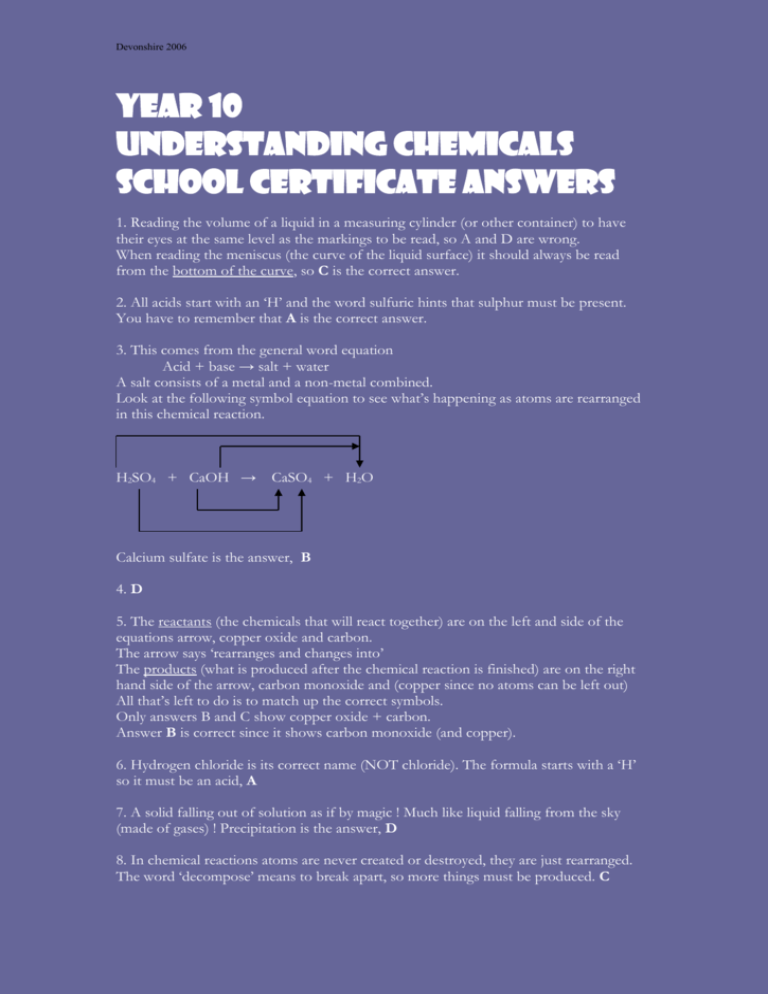Chemicals: Answers - Erina High School
advertisement

Devonshire 2006 Year 10 Understanding chemicals School Certificate answers 1. Reading the volume of a liquid in a measuring cylinder (or other container) to have their eyes at the same level as the markings to be read, so A and D are wrong. When reading the meniscus (the curve of the liquid surface) it should always be read from the bottom of the curve, so C is the correct answer. 2. All acids start with an ‘H’ and the word sulfuric hints that sulphur must be present. You have to remember that A is the correct answer. 3. This comes from the general word equation Acid + base → salt + water A salt consists of a metal and a non-metal combined. Look at the following symbol equation to see what’s happening as atoms are rearranged in this chemical reaction. H2SO4 + CaOH → CaSO4 + H2O Calcium sulfate is the answer, B 4. D 5. The reactants (the chemicals that will react together) are on the left and side of the equations arrow, copper oxide and carbon. The arrow says ‘rearranges and changes into’ The products (what is produced after the chemical reaction is finished) are on the right hand side of the arrow, carbon monoxide and (copper since no atoms can be left out) All that’s left to do is to match up the correct symbols. Only answers B and C show copper oxide + carbon. Answer B is correct since it shows carbon monoxide (and copper). 6. Hydrogen chloride is its correct name (NOT chloride). The formula starts with a ‘H’ so it must be an acid, A 7. A solid falling out of solution as if by magic ! Much like liquid falling from the sky (made of gases) ! Precipitation is the answer, D 8. In chemical reactions atoms are never created or destroyed, they are just rearranged. The word ‘decompose’ means to break apart, so more things must be produced. C Devonshire 2006 9. Indicators are chemicals that change colour depending on the chemicals you add them to. We use indicators to tell us chemical conditions. Are the conditions acidic or basic? A is the answer. 10. C, there are 4 hydrogen (white) atoms and 2 oxygen (black) atoms on each side of the arrow. 11. At 700C X will melt and Y will not. X does react with acids, Y does not. Acid is made of water and X dissolves, Y does not. B is the correct answer. 12. Acids react with carbonates to produce carbon dioxide gas. Acids react with metals to form hydrogen gas. Acids start with a ‘H’. H2O is water, not an acid. That leaves B as the correct answer. 13. When reading this graph the steeper the graph (in a vertical direction), the faster the chemical reaction. Metal Y reacts the quickest because it has the steeper sloped graph line but the reaction is finished after 5 minutes because no more gas is produced. Metal X reacts slower because the slope of the graph is not as steep. It also continues to react and produce gas for over 30 minutes. B is the correct answer. 14. B 15. X has to be a very reactive metal while Y has reacted slowly. Sodium is the most reactive metal in the X column so the answer must be C or D. In the Y column we have aluminium and magnesium. From the Periodic Table magnesium is an active metal (in the first 2 groups of the Periodic Table). The answer is D. 16. Combustion reacts involve oxygen and burning. C 17. D 18. The diagram in step 7 shows a single oxygen atom colliding with an ozone molecule (three oxygen atoms chemically bonded together), so B is the correct answer. 19. Oxygen gas (O2) is shown as two white circles bonded together. Nitrogen gas (N2) is shown as two black circles bonded together. The nitrogen monoxide has one oxygen atom bonded to one nitrogen atom (one white bonded to one black). But in order for the reaction shown to be true their must be equal numbers of oxygen and nitrogen atoms before and after the reaction (equal numbers on either side of the arrow). Answer D is the only correct diagram. 20. The second digit (2) shows the number of hydrogen atoms plus 1. This means there must be one hydrogen atom in ARC-022. The answer is B. 21. 2 carbon atoms + 1 = 1 1 hydrogen atom + 2 = 2 2 fluorine atoms = 2 It is ARC-122 or answer A Devonshire 2006 22. B. Think of what happens when you put magnesium into hydrochloric acid. 23. One compound is broken into two or more chemicals, this is called decomposition, C. 24. Oxygen 25. This is another decomposition reaction. 26. Water 27. Indicators 28. Any chemical that’s formula end with CO3 belongs to the group called carbonates. Carbonates react with acid to produce carbon dioxide gas. 29. The chemicals that react together in a chemical reaction are called reactants. The chemicals that are produced after the reaction is complete are called products. 30. Does not react with acid ‘go to 2’ Cannot see crystals ‘go to 4’ Rock does not burn - shale 31. Rusting is a slow chemical reaction between a metal and oxygen, it is more correctly known as corrosion. 32a. Shiny grey, conducts electricity, sounds like a metal. 32bi. Burns to the eyes from acid splashes. 32bii. Wear safety glasses with clear glass or plastic lenses that completely cover the eye to prevent splashes. 32c. Test tube heat up. Bubbles (gas) appear. The metal disappears






